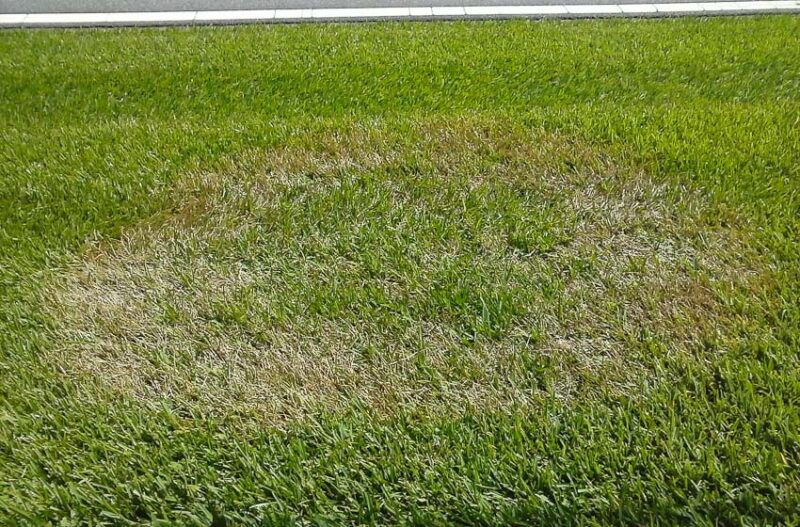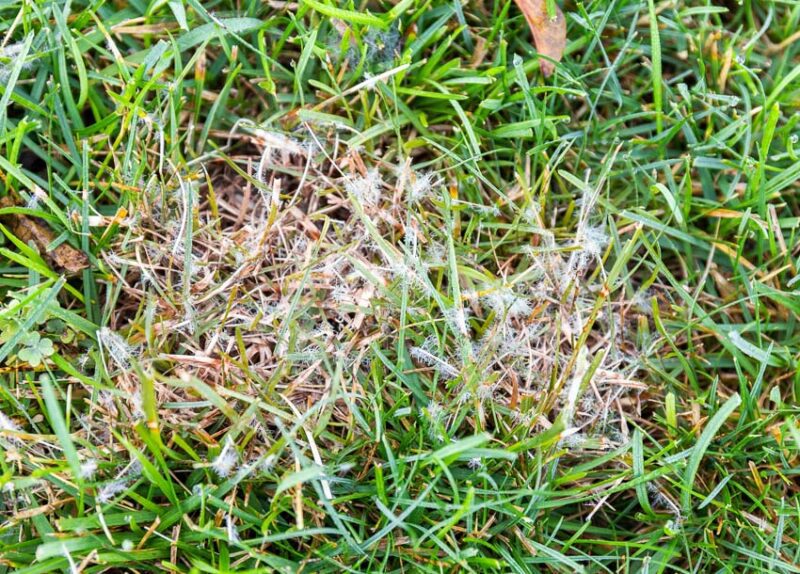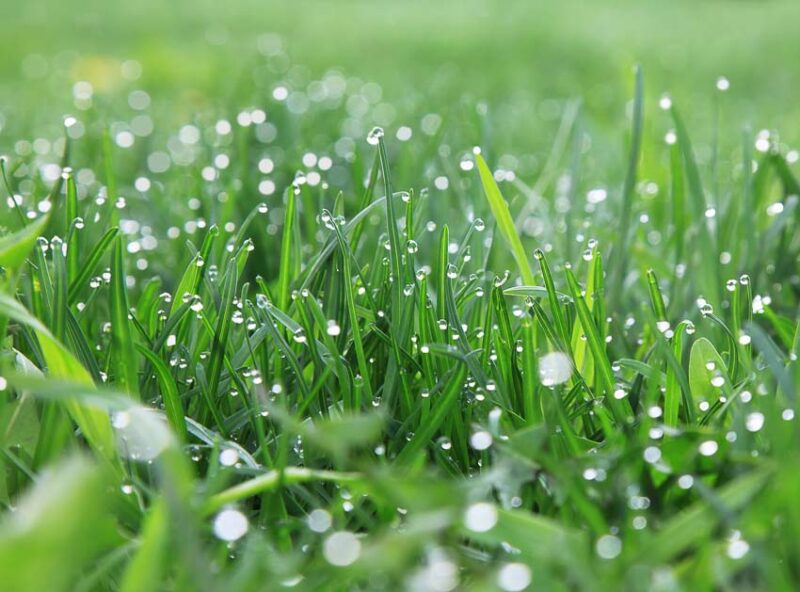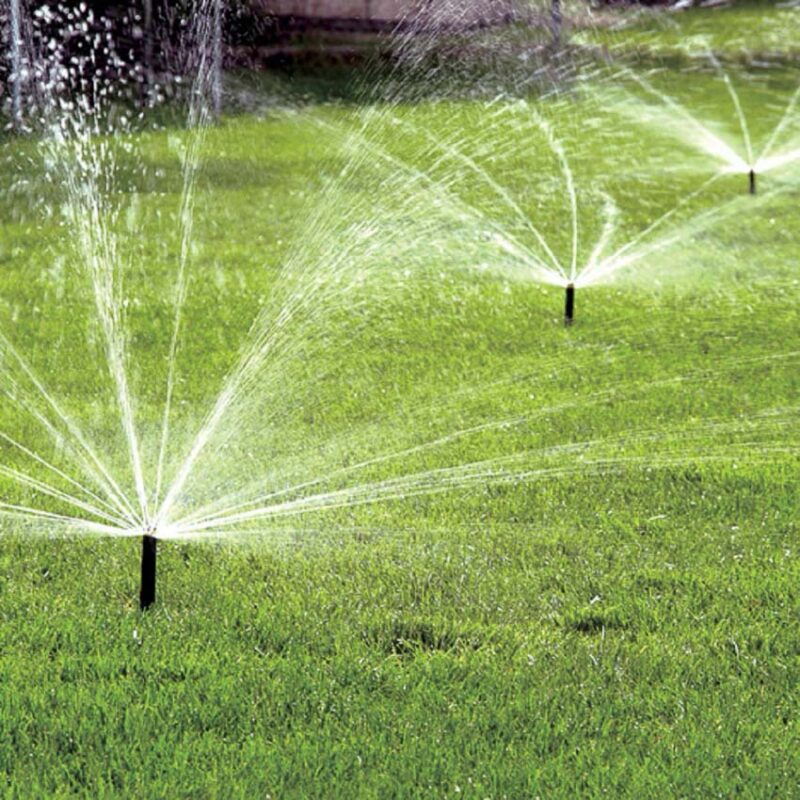Fungal infections are one of the most common lawn problems, and unfortunately, they won’t go away on their own. In this guide, we’ll cover how to rid your lawn of fungus through identification, common causes, and grass fungus treatments.
Identifying Grass Fungus
If you’re not careful, certain lawn maintenance practices can spread grass diseases. Preventative measures should not be skipped—things like washing your tools, bagging your grass clippings, and avoiding watering at night can all make a huge difference in your lawn’s health.
However, let’s not get ahead of ourselves. It’s helpful to talk about avoiding grass fungi while learning how to identify them. Some fungi are more common than others, so let’s go over the best ways to identify and treat the most common types that you’re likely to encounter in your lawn.
Common Signs of Grass Fungus
How do you tell if your lawn is plagued by grass fungus? There are some common signs to look out for. If your lawn suffers from the following symptoms, it could be caused by various types of grass fungus.
- Yellow, brown, or tan patches in your lawn
- Discolored patches that don’t respond to watering
- Large circles or rings of dead grass
- Small bleached spots with dark rings on blades of grass
- Withering, blackened blades of grass
- Red spores that show up on tools and mowers
Types of Grass Fungus
The good news is that with a little bit of research, you should be able to figure out which type of fungus is causing a problem in your lawn.
Let’s go over the most common culprits.
Brown Patch Fungus

Brown patch fungus is the most common type of lawn disease. It affects all grass types, no matter your locale. You’re most likely to see it in mid- to late-summer, especially if you live in a hot, humid climate.
This lawn disease starts out as an ovular or circular yellow patch in your grass. As it advances, the grass blades in the affected area start to rot and turn yellow as the fungus spreads to them.
If not treated promptly, brown patch disease will spread across your whole lawn, and even into surrounding lawns, turning affected areas from green to yellowish to tan. Once you identify brown patch fungus in your lawn, the damage is already done.
The good news is that it’s fairly straightforward to treat and prevent the spread. However, you’ll have to wait for your grass to regrow before your lawn looks as good as new. Since it can be present in your soil for years, you should treat your lawn annually for brown patch fungus to prevent it from returning.
Dollar Spot Fungus

Dollar spot fungus is another very common lawn disease. It thrives in the spring and fall, infecting your grass tissue through cuts in the leaf tips. Dollar spot fungus spreads more quickly during long periods of moisture.
It presents as small dead patches that can be up to 6 inches in diameter. If it advances far enough, it can eventually infect and kill entire patches of grass.
If your soil is poorly fertilized, your lawn is more susceptible to dollar spot fungus. It thrives in mild temperatures and humidity, and it can be exacerbated through poor lawn practices like overwatering.
Rust Fungus
Since there are so many fungi that can cause rust diseases in your lawn, it may be hard to identify the exact cause if you see rust-colored spores around your property.
Rust fungus usually starts out as yellowish specks on your grass blades. These specs then develop into reddish-orange spores that weaken and thin your lawn. You’ll also see these spores on anything that touches your lawn, from your shoes to your lawn mower.
Like other lawn diseases, rust fungus grows and thrives in certain conditions. Rust disease is more common during summer droughts since your grass will be in a weakened state. It spreads via lawn care equipment, shoes, and air.
Understanding Grass Fungus
Identification of grass fungi can be difficult since there are so many common types, but it’s important to know how to narrow down the cause.
What is Grass Fungus?
Grass fungi are naturally occurring species that break down decaying organic matter. In your lawn, this matter includes thatch, dead leaves, and other debris. While some fungi are helpful in the process of breaking down material, others can cause diseases that harm the health of your lawn.
Causes of Grass Fungus

Your lawn’s soil contains many types of grass fungi, but they don’t present themselves unless the right conditions are met. Most fungi are spread by wind, foot traffic, and lawn care tools, meaning there’s no way to avoid them altogether.
Some conditions that can lead to grass fungal infections include:
- High moisture for extended periods
- Poor air circulation
- Excess thatch
- Inadequate fertilization
- Excess shade
- Soil compaction
Lawn treatments are generally only effective if you also address the root causes of grass fungus.
Effective Treatment of Grass Fungus
There are many effective treatment methods for grass fungus. Let’s explore some common treatments for lawn fungal ailments.
Proper Lawn Care Practices
One of the most important factors in preventing your lawn from developing a fungal disease is to practice a good lawn care routine. Things like regular watering, fertilizing, and mowing can make a huge difference in your lawn’s health when done properly. They become even more critical if your lawn does develop a fungal infection.
If you notice fungal diseases in your lawn, you may have to change up your routine to avoid worsening them. Cleaning your mowing equipment and bagging your grass clippings can be effective in preventing the spread.
Fungicide Application

Left untreated, grass fungus will continue to spread and cause damage to your lawn. It will not go away on its own.
Fungicides can be used as a preventative or curative method for grass fungus. Some types, like dollar spot fungus, are best treated with both a fungicide application and nitrogen to cure the disease and address the root cause.
Fungicides come in either a liquid or a granular form. The best time to apply them is during the spring or early summer before they spread and cause lawn damage. You can also try your luck with natural fungicides, such as vinegar and neem oil.
Aeration and Dethatching
Aeration is an important part of a healthy lawn since proper air circulation can prevent disease caused by grass fungus. Along with aerating around once per year, you should also dethatch as necessary to help improve air circulation.
Grass and soil need oxygen to thrive, so increasing circulation helps to promote a lush, disease-resistant lawn. Fungi grow most often in environments that are still and damp, so reducing lawn moisture can help combat fungal growth.
Reseeding and Renovation
Unfortunately, once a fungus disease damages your lawn, there’s no turning back the clock. The damage is already done, so now it’s time to address the dead spots in your grass. If you don’t address them promptly, opportunistic weeds like dandelion and crabgrass can take advantage and set up shop.
If you only have a few bare spots, repairing your lawn is easy. All you need to do it remove the dead grass and scarify the soil surface. Then, just add some compost and plant your grass seed.
You will be especially successful during peak growing conditions, like summer or fall (depending on your grass type and climate). If your lawn is severely damaged, consider hydroseeding it to restore it to its former glory.
How to Prevent Grass Fungus
The best way to get rid of grass fungus is to prevent it from showing up in the first place. If you have a good maintenance schedule, like watering and mowing, you’re less likely to encounter any lawn diseases. However, some types of fungus diseases are caused by poor soil fertility, which you can address by adopting a balanced fertilization schedule.
Proper Watering Techniques

One of the most common causes of lawn fungal growth is overwatering your grass. Not only does overwatering inflate your water bill, it can cause erosion and carry contaminants into drainage systems, harming the environment.
It’s not a good idea to drown your lawn, so you should adopt a proper watering technique to bring your lawn back to good health. The best time to water your grass is in the morning so that is can dry off in the afternoon sun before nightfall.
Most lawns only require around 1 to 1.5 inches of water per week, spread out between a couple of waterings. A rain gauge can help you determine whether or not you’re overwatering your grass. You can also install a sprinkler system to make sure you’re not overdoing it when it comes to watering your lawn, and it will also save you money on your water bill.
Good Lawn Maintenance
As mentioned above, the best way to prevent most lawn diseases and problems is to establish a good lawn maintenance routine. You should do the following chores as regularly as necessary for a healthy lawn:
- Mowing
- Fertilizing
- Watering
- Aerating
- Dethatching
- Liming your lawn
- Soil testing
- Overseeding
Balanced Fertilization
Fertilizing your lawn may seem like a complicated feat, but it’s important to add it to your routine. Underfertilized lawns can highly contribute to grass fungus, however, it’s also easy to overfertilize your lawn, which can damage it and be a waste of money.
It may be tough to know where to start since there are so many choices when it comes to lawn fertilizer. There are synthetic or organic fertilizers, as well as quick-release and slow-release methods.
It may be wise to pay a lawn care professional to handle tasks like fertilizing since they will have more advanced knowledge about what fertilizer to use and when to use it.
FAQ: Common Questions About How to Get Rid of Grass Fungus
1. Can I use natural remedies to treat grass fungus?
There are several ways to treat grass fungus. One of the most popular methods is using vinegar, which can also help you get rid of pests like gophers, snakes, fleas, and ticks. However, high-strength vinegar solutions are effective at killing weeds and grass, so make sure not to oversaturate your entire lawn.
2. Will grass fungus come back after treatment?
Fungus spores may remain in your soil, which can reinfect your grass under the right conditions. If your lawn has suffered from fungus diseases in the past, you should treat your lawn annually with a fungicide to prevent reinfections. Be sure to continue to use best lawn care practices to prevent conditions to encourage fungal growth.
3. Can I treat grass fungus myself, or should I hire a professional?
While it is possible to successfully treat a grass fungal infection yourself, it might be wise to hire a professional if your infection is severe. There are two types of grass fungus treatment methods (preventative and curative), and an experienced lawn care pro will know how to take care of your problem. However, with enough research and know-how, you can treat grass fungus yourself.
4. Is letting pets and children on the lawn safe after applying fungicides?
Always keep children and pets off of your lawn for at least 72 hours after treating it with any type of chemical, fungicides included. Be sure to also keep products away and out of the reach of pets and children to avoid accidental poisoning.
5. How quickly will I see results after treating grass fungus?
Most lawn fungicides take around a week to start working, but damage can’t be reversed once it’s already done. If your grass has died as a result of fungal infections, you may nee to reseed any bare spots. Once you patch your lawn with grass seed, you should see results within a few weeks with good lawn care practices.
Related Content
Best Time to Plant Grass
How to Fix Brown Grass: Causes and Solutions
Mulching vs Bagging Grass: Which is Better for Your Lawn?
